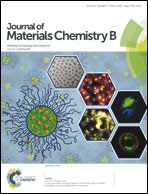Super LCST thermo-responsive nanoparticle assembly for ATP binding through the Hofmeister effect†
Abstract
The present investigation reports the development of a super LCST thermo-responsive amphiphilic nanoparticle assembly for the detection of adenosine triphosphate (ATP) through the Hofmeister effect. For this purpose, a new diblock molecule was designed based on hydrophilic polyethylene glycol and the renewable resource 3-pendadecylphenol as the hydrophobic unit. The amphiphile self-assembled as a 150 nm micellar nanoparticle and showed a super lower critical solution temperature (LCST) above 90 °C. The amphiphile followed the Hofmeister effect for the anion series and exhibited high selectivity for the recognition of ATP over its adenosine precursors such as ADP, AMP and inorganic phosphate (Pi). The preferential binding for ATP is attributed to the encapsulation in the hydrophobic pocket and modification of the hydration shell at the periphery of the amphiphilic nanoparticles. Electron and atomic force microscopes and dynamic light scattering techniques confirmed the size and shape of the amphiphilic assembly and its ATP complexes. Isothermal calorimetric experiments were carried out to determine the binding constants for the amphiphilic nanoparticle binding to ATP. The binding of the amphiphilic nanoparticle to ATP was found to be an endothermic process with a binding constant three times higher compared to its precursor Pi. This investigation provides the first insight into the development of a thermo-responsive scaffold for recognition of ATP.


 Please wait while we load your content...
Please wait while we load your content...